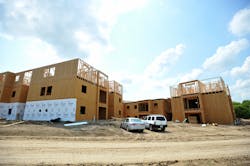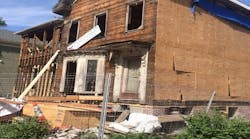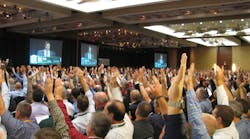Every week it seems that we are seeing reports and videos of huge fires consuming very large lightweight, wood-frame residential buildings—and sometimes multiple buildings. Most of these fires involve projects under construction, but there have also been several fires in recently constructed buildings that were already completed and occupied. Some of the most spectacular fires have spread to several adjacent occupied buildings, causing millions of dollars in property damage as well as threatening the lives of citizens and firefighters.
A major incident on this growing list occurred recently in College Park, MD, in a huge complex that was only weeks from being occupied. The early damage estimates are approximately $40 million. This fire was only a stone's throw from the Department of Fire Protection Engineering at the University of Maryland, which is often viewed as the mountain from which fire protection wisdom descends on stone tablets. In addition, it was within hose-laying distance of the College Park firehouse, where many of today’s leaders in the field of fire protection learned how to fight real fires.
A few weeks later, a similar fire occurred in Boston, very close to the hilltop campus that is occupied by the National Fire Protection Association (NFPA). These incidents are sending out a clear message that despite knowing better, we still manage to build fire risks that are beyond our ability to control.
How did we get here?
Most North American cities used to be prone to very large fires because so much of their building stock was constructed before the development of construction methods, materials and fire protection systems that would effectively contain and control fires. The frequency of large fires declined because most of those buildings either burned down or were demolished and replaced by buildings that were designed to be meet modern codes.
We learned the lessons of urban fire protection over a couple of hundred years, but there is no doubt today that we know how to build large buildings that will not burn to the ground and threaten their neighbors. We still have challenges with building contents, but the fire risk of the buildings themselves is within our ability to control. I think that we can all agree that this type is mega-fire is absolutely preventable if we apply that knowledge.
We seemed to have the problem under control until some great minds got together and rationalized that we can build these extra-large buildings out of combustible materials and justify the fire risk factor by installing automatic sprinklers. At face value this appears to be a reasonable proposition, considering the proven track record of sprinklers in controlling fires. Why not take advantage of the sprinklers to allow for more liberal requirements in terms of height and area limitations, fire separations and allowable building materials?
We start to lose perspective when we extrapolate this assumption by assuming that we can take advantage of sprinkler protection to build very large multi-story buildings using engineered wood assemblies that are reasonably priced, structurally efficient, easy to assemble and extremely non-fire resistant. We maximize the areas between fire walls, allow additional floor levels, reduce the requirements for fire resistance between floor levels, and permit combustible void spaces—what could possibly go wrong? As long as we assume that the sprinklers will take care of any fire that occurs, the risk equation appears to be balanced, but if the sprinklers don't control the flames, we have created the potential for another massive fire.
Fire protection AND life safety
As noted, most of the mega-fires that have involved these buildings have occurred during the construction phase, before the sprinklers were installed or at least before they were operational. At that point, we have a vertical lumber yard—the equivalent of tens of thousands of the wood cribs that are used to create test fires under laboratory conditions. It would be difficult to imaging a better planned fuel array!
One of the strategies that was incorporated into building codes to limit the size of potential fires was to set limits on the height and area of combustible (i.e., wood frame) buildings. Recently those codes have been amended to allow wood-frame construction with the same number of stories, or even additional stories, above a non-combustible (i.e., concrete) pedestal of one or two stories. In other words, we raise the problem higher, where it is even harder to fight a fire, and relax the rules for subdividing the building with fire walls.
To make the fire problem more challenging, the builders insist on building as much as they can simultaneously, so we often encounter not just one oversized flaming lumber array, but several of them in close proximity, so that a fire can easily spread throughout a whole complex. Under the right conditions, the fire can distribute enough radiant heat energy and flying brands to create the type of conflagration scenario that reminds us of the days before we learned how to effectively manage fire risk in the urban environment. Every time I see a video of one of those uncontrollable “apartments under construction” fires, I shake my head and wonder how we managed to forget or simply ignore so much about basic fire protection.
While many of the most spectacular fires involve buildings under construction, we also occasionally encounter a fire of similar proportions in a finished and occupied complex. What happened there? Almost invariably we learn that the fire started in an area without sprinklers and extended into the combustible void spaces, including the attic and floor-ceiling assemblies. Once a fire gets into those spaces, it has free reign to spread throughout the building.
Let’s have a look at NFPA Standard 13R, the standard that applies to the installation of sprinklers in multi-family residential buildings. The standard doesn’t require the void spaces in those buildings to be sprinklered because the standard is primarily concerned with life safety and no one lives in the void spaces. Fires are not supposed to originate in those areas, nor on balconies or terraces or in mulch beds adjacent to combustible exterior cladding. A fire that originates in one of those unprotected areas and spreads to a network of interconnected combustible void spaces is not following the rules.
It made sense when the standard was developed to exclude requirements for sprinklers in the unoccupied enclosed spaces in order to reduce the cost of installation and thus encourage the installation of sprinklers to provide for higher levels of life safety. In the old days, we used sprinklers to protect property, but we didn't focus on using them for life safety. Then we discovered that sprinklers provide superior life safety, and somewhere in the process we stopped being concerned about saving the property. Aren’t we smart enough to manage both?
How many times have we heard a supposed “expert” proclaim that it doesn't matter if the building burns as long as all of the occupants are saved? That logic applies until a mega-fire occurs and people start asking why. Considering the magnitude of some of the fires that have occurred, we are very lucky that there have not been multiple civilian or firefighter fatalities. We need to tabulate the number of close calls that have occurred during firefighting operations in and around these buildings. Are these property losses and the associated risks to firefighters acceptable?
It’s all about money
How did we let ourselves get into this situation, and what are we going to do to fix it? Builders and investors have determined that there is a tremendous market for affordable housing, which means that buildings are constructed at the lowest possible cost and sold or rented at whatever level the market will absorb. Just as home-builders resist requirements to install sprinklers in single-family homes because of the extra cost, their counterparts that build on a larger scale take advantage of sprinklers to build as much as possible at the lowest possible cost. Their goal is to maximize profits and generate returns as quickly as possible. The buyers and tenants assume that those buildings are safe to occupy because they have not studied fire protection engineering.
Most communities want to encourage development, so they are willing to give the developers as much leeway as possible, at least as long as it doesn't jeopardize public safety. If the fire chief starts protesting about the risk level being out of balance, the politicians have to decide which way to lean: Do they promote development or listen to the professional who gets paid to manage fire risk in the community? How many fire chiefs and code officials have been counselled to go easy on the developers because they provide the fuel that drives the economy forward? Very few politicians will knowingly vote for higher risk, but when assured by influential builders that there is no appreciable risk, they are likely to vote for less regulation.
Once upon a time, we looked to insurers to manage risk, but that was back when insurance companies employed risk managers to ensure that losses were kept to a minimum. Somewhere along the way, the insurance industry transformed itself into a financial management business and replaced its fire protection engineers with money managers. It appears that there is no problem obtaining insurance for almost anything these days, and if something burns down, the losses are quickly reimbursed; at least the big losses are reimbursed to the big investors. No one seems to get upset if a fire causes tens of millions of dollars in losses, because those losses are just bumps in the pavement when you are managing hundreds of millions of dollars of other people’s money and making your profits on the investments. Everyone comes out whole, except the little guys who can't afford insurance, and almost invariably the buildings are reconstructed exactly as they were built the first time.
Rethink the problem
When I see these huge fires occurring almost weekly, I feel as sense of shame for my profession. We know how to prevent these fires from occurring, but we don't manage to stop them. We see the problem and we can predict the outcome, but we are players in a big game that appears to accept and even encourage the status quo. Why aren't we demanding reconsideration of the over-liberalized codes that allow these buildings to be constructed? Surely we have enough evidence by now to demonstrate that we went too far in relaxing restrictive codes.
I learned the basics of fire protection engineering almost 50 years ago, and at that time, I had the feeling that we had mastered the challenges of protecting most of the buildings that were being constructed in that era. We knew how to protect them, even if we didn't succeed in having all of them constructed with the appropriate regard for fire protection. We had codes that successfully limited the fire risk in most new buildings to something that was considered acceptable at the time, and the suggestion that a fire could spread to surrounding buildings was unthinkable.
The codes that had been developed by that era were quite successful in keeping fire risk in balance. We also knew how to manage fire risk while buildings were under construction, although many builders would describe those measures as costly, over-restrictive and unrealistic. We knew how to manage fire risk and we still have that capacity, but now we are allowing much higher risk buildings to be constructed and encountering bigger and more destructive fires.
It is time to stop and take a step back to rethink this problem. Fire officials, building officials and fire protection engineers must join forces to change codes and enforce realistic regulations to prevent these unacceptable fires from occurring.










